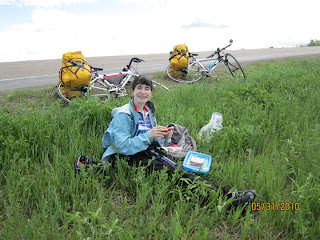Friday was a cold, wet, and windy day for our ride (again). It wasn't as bad as that sounds, however, because we dressed for the rain and cold, and the wind was from the north so it wasn't into our faces (it just hit the left sides of our bodies as we cycled eastward). The weather in northern Montana has been unusually cold and rainy, with the news reports full of flood and wind warnings, and flooded fields and overflowing streams all around us. But we're having a great time, and it's very satisfying to be faced with challenges and overcome them.
We've spent the bulk of the past three days on the Fort Peck Indian Reservation, including most of our Wednesday and Friday rides and a rest day Thursday in Wolf Point, a town in the reservation. We learned something about the reservation from the owner of a sports store in Wolf Point, who was born in Natick, Massachusetts and, after moving around a lot, moved to Wolf Point to "hunt, fish, and get away from people". The Native Americans (which means anyone who's at least one-quarter Native) are under the governance of the tribal rulers, while everyone else (like the sports store owner) is under the governance of the state of Montana and the Federal government. Only the non-Natives pay taxes to the state and federal government. Law enforcement is a complex mix, with tribal law enforcement for the Natives, separate law enforcement for the non-Natives, state highway patrol for everyone, and sheriffs for who knows. On our Friday ride, we saw all sorts of law enforcement vehicles drive by us.
There is, unfortunately, plenty of evidence in what we saw and heard of serious societal problems affecting the Natives. We've heard lots of comments about serious alcohol and drug abuse, and were warned by several people about the danger of staying in any town other than Wolf Point. A headline in today's reservation newspaper talked about a "suicide emergency". Though most of what we saw outside the towns was open space (large flat fields, some cultivated, or rolling hills, some with cattle or horses), we also saw junk lots, sometimes huge ones, right by the side of the road or in front of broken down trailer homes.
Sitting by the slot machines for our Friday morning break
Our Friday lunch stop, combining a restaurant, laundromat, video rentals, and (of course) slot machines
Sharing the one table at our lunch stop
Part of a vast junk heap beside the road in Fort Peck Indian Reservation

























































